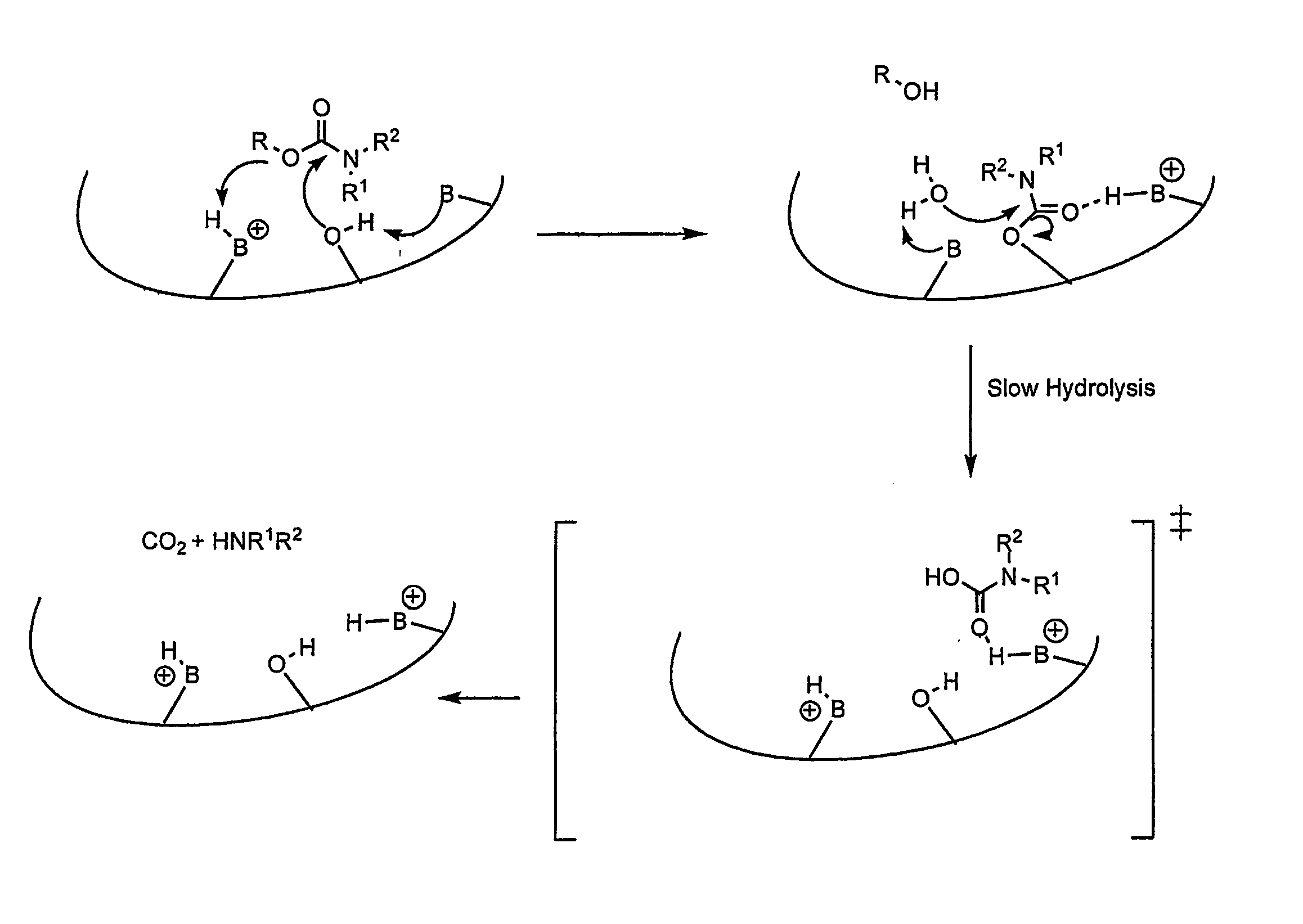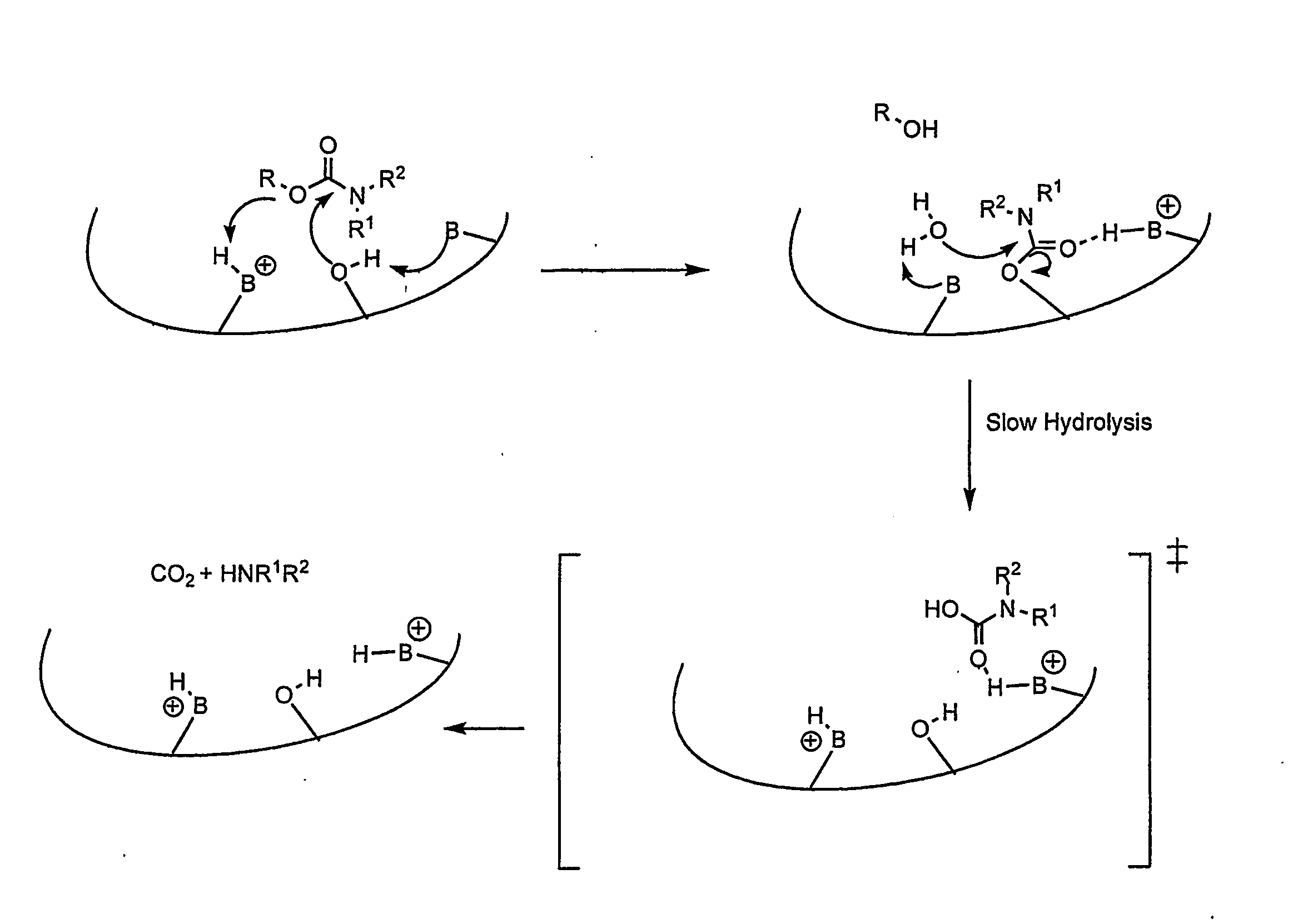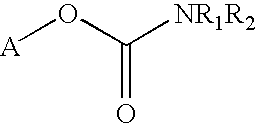Carbamoyl Esters That Inhibit Cholinesterase And Release Pharmacologically Active Agents
a technology of cholinesterase and carbamoyl esters, which is applied in the direction of heterocyclic compound active ingredients, drug compositions, biocides, etc., can solve the problems of insufficient synthesis, release or re-uptake of cell signal molecules, delivery of drugs with a long-lasting effect, and clinical management strategies and currently available drugs are often associated with adverse side effects, so as to increase the amount of amines, and increase the delivery of pharmacologically active amines
- Summary
- Abstract
- Description
- Claims
- Application Information
AI Technical Summary
Benefits of technology
Problems solved by technology
Method used
Image
Examples
example 1
Scheme I. Synthesis of a Carbamoyl Ester
[0164] Seventy three milligrams (73 mg) of NaH (60% dispersion in mineral oil) was added to a solution of 0.3 g (1.82 mmol) (−)-3′-hydroxyphenylethyldimethylamine (1) in 15 ml toluene. The solution was stirred at room temperature for 30 min and then 0.33 g of carbonyldiimidazole (CDI) (2.0 mmol) was added in one portion, and heated to 80° C. for 2 hours. dl-Amphetamine (2) sulfate (0.335 g, 1.82 mmol) was then added and the mixture was stirred at room temperature for 2 days. Distilled water (20 ml) and 15 ml of a 1M HCl solution were added to the reaction mixture and the aqueous and organic layers separated. The aqueous layer was washed with chloroform, basified with 1 M NaOH to pH˜11 and extracted with ether. The ether layer was dried over sodium sulfate, evaporated and purified with a silica gel column (eluted with 3% methanol and 1% triethylamine in ethyl acetate) to yield 0.27 g of the carbamoyl ester (3) (0.83 mmol, 46% yield).
[0165] Th...
example 2
Scheme II. Synthesis of a Carbamoyl Ester
[0166] (S)-(−)-3′-hydroxyphenylethyldimethylamine (96 mg, 0.58 mmol) (1) was dissolved in 4 ml of dry ethyl acetate. N,N′-carbonyldiimidazole powder (283 mg, 1.74 mmol) was added and the mixture stirred at room temperature for 20 h. Acetic acid (313 mg, 5.22 mmol) was then added to the mixture, followed by the addition of 162 mg (−)-atomoxetine (4, 0.63 mmol). The resulting mixture was stirred at room temperature overnight. Saturated sodium bicarbonate solution was added to the mixture and the aqueous and organic layers separated. The aqueous layer was extracted twice with ethyl acetate. The organic layers were combined, dried over NaHCO3, evaporated and purified with a silica gel column (eluted with 25% ethyl acetate in hexane with 1% triethylamine) to yield 101 mg of the carbamoyl ester (5) (0.23 mmol, 39.0% yield). Free base 5 was converted into the hydrochloride salt following the procedure described in Example 14.
[0167] The carbamoyl e...
example 3
Scheme II. Synthesis of a Carbamoyl Ester
[0168] 4-nitrophenychloroformate powder (0.179 g, 0.86 mmol) was added to a solution of 0.12 g (0.72 mmol) (−)-3′-hydroxyphenylethyldimethylamine (1) and 0.22 g (2.17 mmol) triethylamine in 10 ml of dry dichloromethane (0.86 mmol) at 0° C. The solution was stirred at 0° C. for 5 min followed by stirring at room temperature for an additional 30 minutes. A solution of 0.107 g 1-methamphetamine (6) in 2 ml of dry dichloromethane was then added, and the resulting solution stirred at room temperature for 2 hours. The solvent was evaporated and the residue applied to a silica gel column. The carbamoyl ester (7) was eluted with 3% acetone in ethyl acetate containing 1% triethylamine. Fractions containing the carbamoyl ester (7) were combined and concentrated to yield 0.15 g of the carbamoyl ester (7) (0.44 mmol, 61% yield).
[0169] The carbamoyl ester (7) was confirmed by NMR. 1H-NMR (CDCl3, 300 MHz): δ 1.192 (mi) and 1.275 (ma) (d, 3H, J=6.8 Hz, CH...
PUM
| Property | Measurement | Unit |
|---|---|---|
| temperature | aaaaa | aaaaa |
| temperature | aaaaa | aaaaa |
| structure-activity | aaaaa | aaaaa |
Abstract
Description
Claims
Application Information
 Login to View More
Login to View More - R&D
- Intellectual Property
- Life Sciences
- Materials
- Tech Scout
- Unparalleled Data Quality
- Higher Quality Content
- 60% Fewer Hallucinations
Browse by: Latest US Patents, China's latest patents, Technical Efficacy Thesaurus, Application Domain, Technology Topic, Popular Technical Reports.
© 2025 PatSnap. All rights reserved.Legal|Privacy policy|Modern Slavery Act Transparency Statement|Sitemap|About US| Contact US: help@patsnap.com



